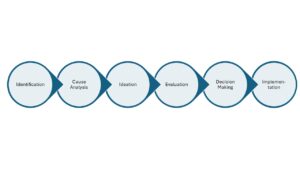Effective problem solving is the cornerstone of a successful business. As organizations become more complex and interconnected, the challenges they face grow in complexity too. Managers are increasingly relying on teams to solve problems collaboratively. But group problem solving is not without its challenges. Miscommunication, conflicting opinions, and poor leadership can derail even the best intentions.
For managers to harness the true power of collaborative problem solving, it’s crucial to understand how to guide and support teams through the process effectively. This blog will cover essential strategies every manager should know about group problem solving, highlighting techniques, best practices, and potential pitfalls to avoid.
Why Group Problem Solving?
Group problem solving combines the diverse perspectives, experiences, and skills of different team members. It can lead to more creative and innovative solutions than what might be achieved by a single manager working alone. However, without the proper structure and guidance, group efforts can lead to conflict, indecision, or suboptimal outcomes.
Here’s why group problem solving is essential for today’s managers:
- Diverse perspectives: Teams bring a variety of viewpoints and experiences, leading to richer discussions and more comprehensive solutions.
- Increased creativity: Collaboration often sparks creativity. One idea can inspire another, leading to breakthrough solutions that might not arise individually.
- Informed decision making: Group discussions allow for a more thorough examination of potential risks and benefits, leading to more informed decisions.
- Shared ownership: When teams are involved in the problem-solving process, they are more likely to take responsibility for the solution and motivated to ensure its success.
The Group Problem Solving Process
For managers, understanding the core stages of group problem solving is vital. Each of the six phases of the process requires specific strategies to maximize team effectiveness.

Figure 1: Problem Solving Process
- Problem Identification
Every effective problem-solving process begins with accurately identifying the problem. However, one common mistake in group settings is focuing on obvious symptoms of the problem without sufficient analysis. Starting with symptoms of the problem rather than digging deeper to find the underlying causes often leads to deadends. To accurately identify and describe a problem in depth requires collecting data about all dimensions of the problem and framing it properly.
Manager’s role:
- Facilitate discussions that dig deeper into the problem rather than surface-level symptoms.
- Encourage team members to ask clarifying questions and to seek answers through data collection.
- Ensure everyone agrees on the problem definition before moving forward.
- Cause Analysis
Problems typically present themselves as symptoms that are obvious. For example, an organization experiencing high levels of absenteeism witnesses obvious symptoms such as staff shortages, overwhelmed customer support and staff burnout. It is tempting to address these symptoms rather than the underlying causes of absenteeism. However, addressing the symptoms alone won’t solve the underlying problem and sometimes even makes it worse.
Manager’s role:
- Use techniques like RCA (root cause analysis) or the 5 Whys method to get to the heart of the issue.
- Use data collection techniques like interviews, observation and surveys to gain insight into how the problem arose and how it affects the organization.
- Use consensus building techniques to arrive at the most likely root causes of the problem.
- Ideation
Once the problem is clearly identified and the root causes are established, the next step is brainstorming solutions. The process of ideation requires creative thinking that often involves novel, untested solutions.
Manager’s role:
- Create an environment that encourages open, judgment-free idea generation. The more ideas, the better, even if some seem impractical.
- Utilize brainstorming techniques such as mind mapping or nominal group technique (where team members write down ideas individually before sharing) to avoid groupthink.
- Encourage quieter team members to share their ideas. Sometimes the most innovative solutions come from unexpected voices.
- Avoid prematurely dismissing ideas. Let the team explore possibilities before evaluating feasibility.
- Evaluation of Solutions
After generating a list of possible solutions, the team must evaluate the feasibility, risks, and benefits of each. This stage can often be contentious as individuals may have strong preferences for specific solutions.
Manager’s role:
- Lead structured discussions that objectively evaluate solutions based on criteria such as cost, time, resources, and potential impact.
- Encourage constructive criticism and respectful debate.
- Use tools like a decision matrix or SWOT analysis (Strengths, Weaknesses, Opportunities, Threats) to compare solutions systematically.
- Decision Making
Reaching a decision in a group can be one of the most challenging aspects of problem solving. Differing opinions can cause friction and may result in a stalemate.
Manager’s role:
- Strive for a consensus-driven decision that everyone can live with or, if necessary, make the final call while being transparent about your reasoning, including recognizing the risks.
- Ensure that the final decision is clearly communicated and that everyone understands the rationale behind it.
- Address any concerns or objections openly to maintain group cohesion.
- Reinforce the idea that once a decision is made, the team must rally behind it, even if it wasn’t everyone’s first choice.
- Implementation
A solution is only as good as its execution. Without a clear implementation plan, even the best ideas can fail.
Manager’s role:
- Assign clear roles and responsibilities to ensure accountability during implementation.
- Set specific, measurable, achievable, relevant, and time-bound (SMART) goals to track progress.
- Monitor the implementation closely and encourage regular feedback loops to address unforeseen challenges.
- Remain available to provide guidance and support as the team executes the solution.
- Schedule a post-mortem or retrospective meeting after the solution has been implemented to evaluate its effectiveness. Encourage open discussions about what worked well and what didn’t.
- Document lessons learned and ensure that these insights are shared and applied in future problem-solving efforts.
- Celebrate successes to reinforce positive behavior and acknowledge team efforts.
Best Practices for Managing Group Problem Solving
In addition to understanding the problem solving process, managers should be aware of best practices to foster effective collaboration and ensure productive problem solving outcomes:
- Foster a Collaborative Culture:
- Create a safe, inclusive environment where team members feel comfortable sharing ideas without fear of judgment.
- Encourage active listening and respect for differing opinions.
- Build trust by recognizing each team member’s unique skills and contributions.
- Effective Facilitation:
- A good manager is a skilled facilitator, not a dictator. Guide discussions without dominating them.
- Keep the team focused on the task at hand and intervene when discussions drift off course.
- Use time management techniques, like setting time limits for each discussion point, to ensure that meetings remain productive.
- Balance Diversity and Cohesion:
- Leverage the diverse strengths of the team but be mindful of potential points of conflict.
- Promote divergent thinking (where team members explore multiple possibilities) followed by convergent thinking (where the team narrows down to a single solution).
- Conflict Resolution:
- Healthy conflict is part of effective problem solving, but unresolved tensions can derail progress.
- Be proactive in mediating disputes, ensuring that conflicts focus on ideas rather than becoming personal.
- Promote compromise and collaboration over competition.
- Encourage Accountability:
- Ensure that everyone is accountable for their part of the solution’s implementation.
- Use tools like RACI charts (Responsible, Accountable, Consulted, Informed) and Project WBS (Work Breakdown Structures) to clarify responsibilities.
- Regularly check in with team members to monitor progress and provide support when needed.
Common Pitfalls to Avoid
- Groupthink: When teams are overly cohesive, they may prioritize harmony over the best decision. Encourage critical thinking and dissenting opinions to counteract this.
- Lack of Structure: Without a clear framework, group problem solving sessions can become chaotic and contentious. Use structured approaches like Six Thinking Hats or the Delphi method to guide discussions.
- Ignoring Individual Input: Ensure that quieter team members have opportunities to contribute. Dominating voices can skew decisions and reduce the quality of outcomes.
Conclusion
Group problem solving can be an incredibly powerful tool for managers if done correctly. By guiding teams through the process, fostering open communication, and ensuring accountability, managers can help their teams achieve more innovative, comprehensive, and effective solutions. Remember, the key is not just to solve the problem but to facilitate a process that brings out the best in every member of your team.


